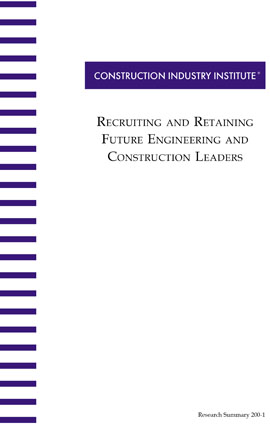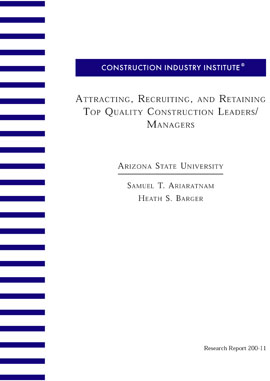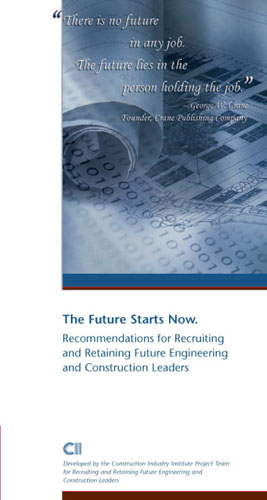
Recruiting and Retaining Future Engineering and Construction Leaders
The engineering and construction industry is failing to recruit enough young professionals. Unfortunately, attracting talent is not the only problem. Retaining them is proving difficult as well. Considering that the typical engineering professional is in their late 30s to early 40s, this long-brewing problem will worsen unless action is taken.
Over the last 20 years, the Construction Industry Institute (CII) has concentrated on craft labor, worker productivity, and the looming shortage of skilled crafts in the U.S., but until now has not addressed the question of how to recruit and retain leaders. CII chartered the Attract, Recruit, and Retain Engineering and Construction Leaders Project Team (PT 200) to explore the problem and to provide solutions that can be implemented by organizations throughout the industry. Such a program, CII believes, could mean large gains for the industry by enhancing the advantages of engineering or construction management careers.
PT 200 has concluded that solutions are indeed available. The project team has identified specific benefits, programs, and other incentives that young people are looking for when choosing a career path and a prospective employer, and has prepared a brochure and a checklist for organizations interested in a self-assessment of their recruiting and retaining efforts. The brochure and checklist are free as downloads from the CII website.
This report summarizes the efforts of the CII research on attracting, recruiting, and retaining engineering and construction leaders. The industry would do well to take note of the examples being set by others, such as the healthcare and information technology industries, and to remove some of the key barriers that are causing young, talented professionals to look away from construction as a lifelong career. The industry needs talented young leaders, and recruiting and retaining them is critical to the future of construction.
Discovered key traits of the young workforce/future manager age group, including the following significant findings: (RS200-1, p. 6)
- 58% of those interviewed place "extremely high value" on the image of the company they work for.
- 26% of respondents expect to change companies five or more times in order to advance their career.
- The younger employees were significantly more likely to relocate to another part of the U.S. for work, while those nearing retirement age and the newest to the workforce were most likely to be willing to temporarily relocate for work.
Young professionals in the E&C industry are attracted to "Variety of Work" and "Pay," in that order. Interestingly, ages 19-24 are most attracted to variety, while ages 25+ are most attracted to pay. (RS200-1, p. 14)
- Key reasons that indicate a high level of personal career satisfaction:
- Seeing a job through completion, on schedule and budget
- Recognition
- Working with co-workers
- Satisfying the client
- Problem solving
- Key reasons driving career dissatisfaction stems from the following areas:
- Not being recognized for a job well done
- Project behind schedule, over budget, or failing for another reason
- Job security due to cyclical nature of industry
- No defined career path
- Lack of leadership and communication with management
- Time commitments
- Relocation
- Repetitive tasks
- Most important action their company could take to advance career satisfaction:
- Competitive compensation and benefits
- Better career path definition
- Continual training and education
- Increased mentoring
- More job recognition
- Challenging environment
- Better communication throughout the organization
- Career advancement opportunities
- Compensation and company benefits
- Great working environment
- Co-workers
- Flexible work options
- Strong leadership
- Job stability



